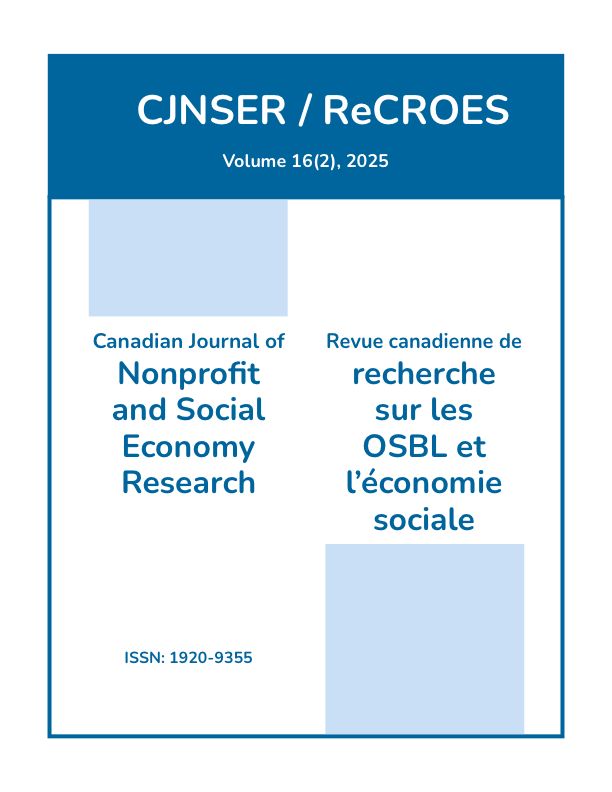Spaces of Belonging: Community Engagement and Social Inclusion in Rural Communities
DOI:
https://doi.org/10.29173/cjnser789Keywords:
third places, regional development, community engagement, social inclusionAbstract
This article explores the crucial role of public spaces and the nonprofit sector in fostering social inclusion within rural communities facing increasing centralization. Challenging purely economic development models, it argues for a holistic understanding of regional wellbeing centred on community engagement in “third places.” By examining the dynamics of space use and the potential for social isolation, the article highlights the importance of human-scale design and strategic revitalization of community-centred spaces to enhance social capital, quality of life, and resilience in smaller urban contexts. It calls for further research into the lived experiences and wellbeing of residents in these areas, advocating for a shift beyond purely economic indicators of local development.
Downloads
References
Eurostat. (2024). Quality of life indicators - measuring quality of life. Eurostat. Retrieved 20.12.2024 from https://ec.europa.eu/eurostat/statistics-explained/index.php?title=Quality_of_life_indicators_-_measuring_quality_of_life
Gehl, J. (1971). Livet mellem husene. Arkitektens Forlag.
Gehl, J. (2011). Life between buildings : using public space (1st ed.). Island Press.
Hauge, A., Calignano, G., Bern, A., & Lønningdal, K. H. (2023). Small cities: Regional motors or sponges? The case of Inland County, Norway. GeoJournal, 88(6), 6393-6406.
Klinenberg, E. (2018). Palaces for the people: How social infrastructure can help fight inequality, polarization, and the decline of civic life. Crown.
Latham, A., & Layton, J. (2019). Social infrastructure and the public life of cities: Studying urban sociality and public spaces. Geography Compass, 13(7), e12444. https://doi.org/https://doi.org/10.1111/gec3.12444
Mayer, H., & Lazzeroni, M. (2022). A Research Agenda for Small and Medium-Sized Towns. Edward Elgar Publishing. https://doi.org/10.4337/9781800887121
Oldenburg, R. (1999). The great good place : cafés, coffee shops, bookstores, bars, hair salons, and other hangouts at the heart of a community. Cambridge. http://lib.ugent.be/catalog/rug01:001297291
Downloads
Published
Issue
Section
License
Copyright (c) 2025 Atle Hauge, Giuseppe Calignano, Elisabeth Winsents

This work is licensed under a Creative Commons Attribution 4.0 International License.
Submission of an original manuscript to the Canadian Journal of Nonprofit and Social Economy Research / Revue canadienne de recherche sur les OSBL et l'économie sociale [thereafter CJNSER] will be taken to mean that it represents original work not previously published, and that it is not being considered elsewhere for publication.
The journal takes the stance that the publication of scholarly research is meant to disseminate knowledge and, in a not-for-profit regime, benefits neither publisher nor author financially. It sees itself as having an obligation to its authors and to society to make content available online now that the technology allows for such a possibility. In keeping with this principle, the journal will publish all of its issues online.
Authors who publish in CJNSER agree to release their articles under the Creative Commons 4.0 International Licence (CC BY). This licence allows anyone to copy and distribute the article provided that appropriate attribution is given. For details of the rights an author grants users of their work, please see the licence summary and the full licence.
[Content published between 2010 and 2019-10 was licensed under the Creative Commons Attribution-NonCommercial-NoDerivs 2.5 Canada (CC BY-NC-ND 2.5 CA) License. Content published between 2019-10 to 2023-12 was licensed under the Creative Commons Attribution-NonCommercial-NoDerivatives 4.0 International (CC BY-NC-ND 4.0) License. Content published after 2023-12 is licensed under the Creative Commons 4.0 International (CC BY) License.]



